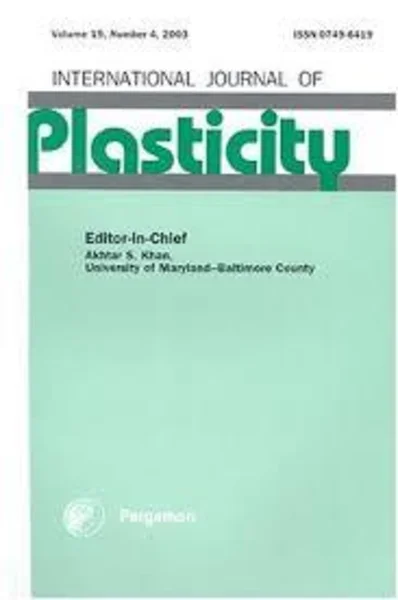-
continuum modeling of the response of a mg alloy az31 rolled sheet during uniaxial deformation
جزئیات بیشتر مقاله- تاریخ ارائه: 1390/01/01
- تاریخ انتشار در تی پی بین: 1390/01/01
- تعداد بازدید: 633
- تعداد پرسش و پاسخ ها: 0
- شماره تماس دبیرخانه رویداد: -
lightweight magnesium alloys, such as az31, constitute alternative materials of interest for many industrial sectors such as the transport industry. for instance, reducing vehicle weight and thus fuel consumption can actively benefit the global efforts of the current environmental industry policies. to this end, several research groups are focusing their experimental efforts on the development of advanced mg alloys. however, comparatively little computational work has been oriented towards the simulation of the micromechanisms underlying the deformation of these metals. among them, the model developed by staroselsky and anand [staroselsky, a., anand, l., 2003. a constitutive model for hcp materials deforming by slip and twinning: application to magnesium alloy az31b. international journal of plasticity 19 (10), 1843–1864] successfully captured some of the intrinsic features of deformation in magnesium alloys. nevertheless, some deformation micromechanisms, such as cross-hardening between slip and twin systems, have been either simplified or disregarded. in this work, we propose the development of a crystal plasticity continuum model aimed at fully describing the intrinsic deformation mechanisms between slip and twin systems. in order to calibrate and validate the proposed model, an experimental campaign consisting of a set of quasi-static compression tests at room temperature along the rolling and normal directions of a polycrystalline az31 rolled sheet, as well as an analysis of the crystallographic texture at different stages of deformation, has been carried out. the model is then exploited by investigating stress and strain fields, texture evolution, and slip and twin activities during deformation. the flexibility of the overall model is ultimately demonstrated by casting light on an experimental controversy on the role of the pyramidal slip 〈c + a〉 versus compression twinning in the late stage of polycrystalline deformation, and a failure criterion related to basal slip activity is proposed.
مقالات جدیدترین رویدادها
-
استفاده از تحلیل اهمیت-عملکرد در ارائه الگوی مدیریت خلاقیت سازمانی و ارائه راهکار جهت بهبود
-
بررسی تاثیر ارزش وجوه نقد مازاد بر ساختار سرمایه شرکت های پذیرفته شده در بورس اوراق بهادار تهران
-
بررسی تأثیر سطح افشای ریسک بر قرارداد بدهی شرکت های پذیرفته شده در بورس اوراق بهادار تهران
-
بررسی تأثیر رتبه بندی اعتباری مبتنی بر مدل امتیاز بازار نوظهور بر نقد شوندگی سهام با تأکید بر خصوصی سازی شرکت ها
-
تأثیر آمیخته بازاریابی پوشاک ایرانی بر تصویر ذهنی مشتری پوشاک ایرانی (هاکوپیان)
-
روش اجرای پل بتنی دال و تیر مطالعه موردی مراحل اجرای پل ارتباطی سرریز سد کرخه
-
شبیه سازی نحوه پخش و انتشار ترکیبات آلی فرار خروجی از فلرهای پالایشگاه های پارس جنوبی با نرم افزار aermod
-
بررسی و مقایسه رویکردهای یادگیری مورد استفاده اساتید در دروس معماری به منظور بهبود فرایند آموزش در معماری
-
ارزیابی و سنجش میزان عزت نفس و پیشرفت تحصیلی متاثر از برنامه های آموزشی مختلف در مدارس شهرستان پیرانشهر
-
راهکارهای افزایش بهبود جمع و تفریق با کمک بازی در یکی از دانش اموزان کلاس دوم ابتدایی مدرسه الزهرا
مقالات جدیدترین ژورنال ها
-
مدیریت و بررسی افسردگی دانش آموزان دختر مقطع متوسطه دوم در دروان کرونا در شهرستان دزفول
-
مدیریت و بررسی خرد سیاسی در اندیشه ی فردوسی در ادب ایران
-
واکاوی و مدیریت توصیفی قلمدان(جاکلیدی)ضریح در موزه آستان قدس رضوی
-
بررسی تاثیر خلاقیت، دانش و انگیزه کارکنان بر پیشنهادات نوآورانه کارکنان ( مورد مطالعه: هتل های 3 و 4 ستاره استان کرمان)
-
بررسی تاثیر کیفیت سیستم های اطلاعاتی بر تصمیم گیری موفق در شرکتهای تولیدی استان اصفهان (مورد مطالعه: مدیران شرکتهای تولیدی استان اصفهان)
-
پیش بینی دلزدگی زناشویی بر مبنای ذهن آگاهی، بهزیستی روانشناختی و انعطاف پذیری شناختی زوجین مراجعه کننده به مراکز مشاوره
-
بررسی و نقد ادله کنترل جمعیت از دیدگاه فتاوای فقهای معاصر
-
بررسی ارتباطات اثربخش و سکوت سازمانی مطالعه موردی: سازمان آب و فاضلاب شهری خراسان جنوبی
-
بررسی رابطه بین اقدامات مدیریت منابع انسانی با عملکرد سازمانی با توجه به نقش میانجی مدیریت دانش وتعدیلی فرهنگ سازمانی کارکنان شبکه بهداشت و درمان در استان گلستان
-
بازآفرینی فرهنگی شهر با تکیه بر خلق فضای پاتوق شهری نمونه موردی: شهر اردبیل




سوال خود را در مورد این مقاله مطرح نمایید :